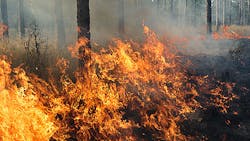Tucson Electric Power Prepared to Mitigate Risks of Wildfires
With wildfires sweeping Arizona early this year, Tucson Electric Power (TEP) stands ready to respond to ensure the safe, reliable delivery of energy to customers. Throughout the year, TEP takes steps to protect and fortify its high-voltage transmission lines and to plan its response if a wildfire threatens the grid.
The 2020 Bighorn Fire — which was sparked by lightning and destroyed 120,000 acres in the Catalina Mountains — serves as a reminder of the serious threat that wildfires pose to personal safety, property and electric reliability.
TEP’s 1500 miles of high-voltage lines span remote forests and deserts in Arizona and New Mexico, areas often prone to wildfires. Because these lines deliver power from remote generating facilities, widespread outages can occur if they’re damaged or shut down due to a wildfire.
Monitoring and Prevention
One of the ways to protect these transmission lines is to maintain a wide clearance of up to 300 feet with nearby vegetation. TEP trims back trees and shrubs that encroach on its lines to remove fuel sources for wildfires, creating a firebreak.
Kasy Schug, TEP Vegetation Management project manager, and Greg Wildman, transmission circuit patrolman, are responsible for inspecting the lines, equipment and vegetation along transmission corridors. Twice a year for four days — before and after wildfire season — Schug and Wildman conduct aerial inspections by helicopter.
Schug looks for vegetation that may grow too close to TEP's lines and equipment, while Wildman focuses his attention on the condition of the lines and equipment.
“I inspect everything — both old and new equipment,” said Wildman, a veteran employee who has worked on TEP's transmission lines for 25 years. “My focus is on the reliability of our transmission circuit, so I’m looking at lines, towers, insulators, guidewires, anchors and other equipment to make sure there’s been no damage and to note if repairs are needed.”
Extra-high-voltage transmission facilities are inspected once every five years, while high-voltage facilities are inspected annually. The tree-trimming efforts reach every mile of TEP's transmission corridors at least once every five years.
To get a closer look at the transmission assets, Wildman conducts foot patrols once annually to check for signs of corrosion, loose bolts or damaged insulators. Wildman also uses software that helps determine the integrity of TEP's 5000 towers based on responses to a series of questions. Work orders for repairs are requested for towers with lower scores.
Wildfire Preparation
TEP works with local, state, federal and tribal agencies and private landowners to plan and prepare a coordinated wildfire response. “We keep in close contact and communicate regularly with these agencies throughout the year,” Schug said.
He and Wildman also participate in the U.S. Forest Service’s annual wildfire meeting, where agencies discuss the expected severity of the upcoming wildfire season, review response protocols for managing fires, and coordinate agency resources. They also participate annually in wildfire training courses that focus on safety.
Watching Weather Conditions
Monitoring weather and wildfire conditions for Arizona and New Mexico also helps in the electric utility company's preparations. Employees regularly check state and federal wildfire and emergency management websites for areas of elevated wildfire risk as well as active and newly reported fires.
The company overlays maps of active fires with maps of its lines and equipment and towers to determine the proximity of fires to its equipment. If necessary, crews are dispatched to the area.
“In addition to checking the long-term weather forecasts, we also review the heat index and precipitation forecast so that we’re aware of conditions and can react quickly,” Schug added.
Boots on the Ground
When fires approach the transmission lines or equipment, Wildman goes into the field to serve TEP’s liaison with firefighting agencies.
“I make contact with the incident command center and position myself in a location where I can observe the fire, but remain out of harm’s way,” he said, adding it’s important to keep open communication with fire officials since fire retardant can interfere with TEP's lines.
Wildman also provides field updates to TEP’s Emergency Management Team so that employees in other departments can respond and deploy resources as needed.
“Unfortunately, wildfires can’t be prevented because we know they will occur,” said Schug, “but we can prepare for them to mitigate the potential threat to our assets. Because we provide an essential service, it’s important that we provide reliable energy to our customers.”
